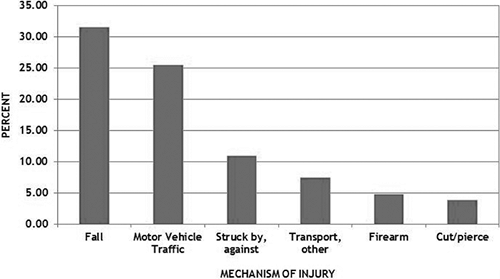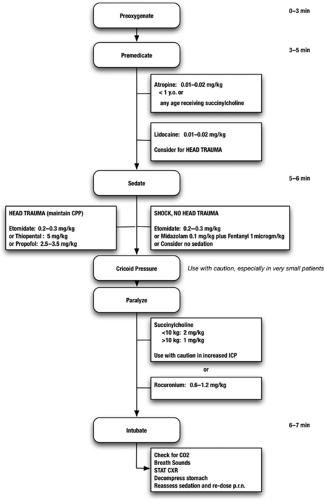Trauma in Children
Daniel J. Grabo
Thane A. Blinman
Michael L. Nance
C. William Schwab
I. Introduction
Nearly 8 million children under the age of 15 visit the emergency department yearly for injury in the United States. Advances in injury prevention and healthcare have led to a decrease in the number of deaths from unintentional injury in children from 1997 to 2007 by 30%. Unintentional injury remains the cause of more childhood (ages 1 to 14) deaths than all other childhood diseases combined and is responsible for nearly 30% of all years of potential life lost.
Most pediatric trauma care occurs outside the setting of a designated pediatric trauma center. It is imperative that any treating hospital, knowing the limitations of their institution, transfer severely injured children to a higher level of care when conditions exceed capabilities. Pre-existing transfer agreements between institutions facilitate transfer and care.
II. Mechanism of Injury (Fig. 21A-1)
Blunt trauma accounts for more than 90% of pediatric injuries.
Falls are the most frequent type of injury.
Motor-vehicle collisions are the most frequent cause of injury-related mortality.
Penetrating trauma accounts for less than 10% of pediatric trauma admissions.
Penetrating trauma is three times as lethal as blunt trauma.
Seventy percent of deaths occur at the scene.
Firearm injuries are the most lethal (case fatality rate of 9% to 17%).
III. Anatomy and Physiology
Anatomic and physiologic differences between children and adults can have potential clinical consequences (Table 21A-1). In addition, normal measurements of respiratory rate (RR), heart rate, and systolic blood pressure (SBP) differ from adults and vary with increasing age in infants and children (Table 21A-2).
Table 21A-1 Gener al Body Differences between Children and Adults and Potential Clinical Consequences
General body difference
Potential clinical consequence
Decreased mineralization
Less protection to structures in central nervous system, thorax
Decreased strength
Diminished protection of c-spine, abdomen
Decreased contractility in response to Starling effect
Dependence on increase in heart rate to maintain cardiac output
Poor tolerance of fluid overload
Distribution of masses
Different injury patterns
Abdominal contents ride higher in chest Bladder sits above pelvic brim
Larger heart
Airway differences
Altered approach to diagnosis and management
Large surface area to weight ratio
Vulnerable to hypothermia
Shorter neck, larger head, laxity of ligaments, decreased muscle support
Increased risk head injury and flexion injury to the c-spine
Table 21A-2 Age-s pecific Normal Vital Signs
Age group weight range
Respiratory rate (breaths/min)
Heart rate (beats/min)
Systolic blood pressure (mm Hg)
Urinary output (mL/kg/h)
Infant: 0–12 mos (3–5 kg)
<60
<160
>60
2.0
Toddler: 1–2 y (10–14 kg)
<40
<150
>70
1.5
Preschool: 3–5 y (14–18 kg)
<35
<140
>75
1.0
School age: 6–12 y (18–36 kg)
<30
<120
>80
1.0
Adolescent: 13 y (36–70 kg)
<30
<100
>90
0.5
Adapted with permission from the American College of Surgeons, Committee on Trauma. Advanced Trauma Life Support for Doctors, ATLS® Student Course Manual, 8th ed. Chicago, IL; 2008. Chapter 10.
Table 21A-3 Airwa y Equipment
Age range weight (kg)
Distance (cm) midtrachea to lip
Endotracheal tube (uncuffed)
Laryngoscope blade
Premie (3)
8.0
2.5–3.0
0 straight
0–6 mos (3.5)
8.0–11.0
3.0–4.0
1 straight
6–12 mos (7)
11–12.5
4.0–4.5
2 straight
1–3 y (10–12)
12.5–14.0
4.5–5.0
2 straight
4–7 y (16–18)
14.0–17.0
5.0–6.5
2 straight
8–10 y (24–30)
17.0–20.0
6.5–10.0
2–3 straight/curved
In adolescents age 12+ and young adults, use adult sized, cuffed endotracheal tubes. Adapted with permission from the American College of Surgeons, Committee on Trauma. Advanced Trauma Life Support for Doctors, ATLS® Student Course Manual, 8th ed. Chicago, IL; 2008. Chapter 10.
IV. Primary Survey
The goals of initial management of pediatric trauma are the same as adult trauma: Restore and maintain oxygen delivery; discover and manage injuries in order of greatest threat to life; move efficiently to definitive treatment. Specific differences in pediatric anatomy and physiology determine key modifications to the standard age-independent protocols of ATLS®. Rapid access to internet-based resources can help in the management of the injured child and include considerations in Pediatric Trauma (http://emedicine.medscape.com) as well as Pediatric Trauma and Pediatric Resuscitation (www.uptodate.com).
Airway
A speaking, crying, or spontaneously breathing child likely has a patent airway. Nasal flaring and sternal retractions are hallmark signs of respiratory compromise. Stridor, hoarseness, and change in the quality of voice can indicate laryngeal spasm or airway edema.
Oropharyngeal obstruction is most commonly caused by the tongue and can be managed in most cases by oral suctioning and head positioning or by placing the chin in the “sniffing position” while taking care to maintain cervical spine (c-spine) immobilization if indicated.
Bag-valve-mask (BVM) ventilation provides adequate oxygenation and ventilation for most pediatric trauma patients.
All trauma centers should have a protocol (Fig. 21A-2) for pediatric rapid sequence intubation (RSI). Indications for intubation include inability to protect the airway (e.g., Glasgow Coma Scale (GCS) score ≤8; significant facial trauma), inability to ventilate (e.g., flail chest), or inability to oxygenate (e.g., smoke inhalation).
The pediatric airway differs from the adult as follows: Shorter trachea causing frequent mainstem intubation and easy extubation; prominent occiput, large tongue, and smaller mouth make oral tracheal intubation difficult. An uncuffed
tube is recommended in young children to minimize airway trauma (Table 21A-3).
Nasotracheal intubation is not recommended due to the sharp angle between the nasopharynx and oropharynx. Surgical airway is rarely indicated, especially in children less than 8 years. Surgical cricothyroidotomy and translaryngeal jet ventilation (needle) are options in older children (>12 years).
Drug doses for airway and cardiopulmonary support plus device size and care protocols can be gleaned from the age and body mass–based color-coded scheme on the Broselow® Pediatric Emergency Tape.
Breathing
Airway or ventilatory compromise is the most common cause of cardiac arrest in children.
Auscultate in the axillae to minimize noise from contralateral chest. Decompress the stomach to avoid its compromising breathing efforts.
If tension pneumothorax is suspected, perform needle decompression followed by chest tube insertion. The preferred placement of the catheter for chest decompression is in the fourth or fifth interspace at the anterior axillary line. Hemothorax or pneumothorax on chest radiograph or suspected clinically is treated with chest tube insertion. Consider insertion of the smallest caliber chest tube or pigtail catheter for isolated pneumothorax (Table 21A-4).
Ventilate at a rate and volume according to age and size. Normal spontaneous tidal volumes (TV) range from 6 to 8 mL/kg for infants and children, although larger TV (7 to 10 mL/kg) are frequently required during assisted ventilation. See Table 21A-2 for age-appropriate RR.
Inability to hear adequate breath sounds in both lung fields after endotracheal intubation raises the concern for mainstem intubation (most commonly the right) or pneumothorax. Assess the endotracheal tube location and obtain a chest radiograph after intubation, movement or manipulation, or if clinical conditions abruptly change.
Table 21A-4 Supplemental Equipment
Age range
OG/NG tube
Urinary catheter
Chest tube
Premie
8 Fr
5 feeding
10–14 Fr
0–6 mos
10 Fr
5–8 feeding
12–18 Fr
6–12 mos
10 Fr
8 Fr
14–20 Fr
1–3 y
12 Fr
10 Fr
14–24 Fr
4–7 y
12 Fr
10–12 Fr
20–28 Fr
8–10 y
14 Fr
12 Fr
28–38 Fr
Fr is size in French.
OG, orogastric; NG, nasogastric.
Adapted with permission from the American College of Surgeons, Committee on Trauma. Advanced Trauma Life Support for Doctors, ATLS® Student Course Manual, 8th ed. Chicago, IL; 2008. Chapter 10.
Table 21A-5 Syste mic Response to Hypovolemic Shock in Children (Table 46-5)
System
<25% blood loss
25%–45% blood loss
>45% blood loss
Cardiac
Weak, thready pulse; increased heart rate
Increased heart rate
Hypotension; tachycardia to bradycardia
Central nervous system
Lethargic, irritable, confused
Change in level of consciousness; dulled response to pain
Comatose
Skin
Cool, clammy
Cyanotic, decreased capillary refill, cold extremities
Pale, cold
Kidneys
Minimal decrease in urinary output, increased specific gravity
Minimal urine output
No urinary output
Reproduced with permission from Gaines BA, et al. Pediatric trauma. In: Peitzman AB, Rhodes M, Schwab CW, et al., eds. The Trauma Manual: Trauma and Acute Care Surgery. 3rd ed. Philadelphia, PA: Wolters Kluwer/Lippincott Williams & Wilkins; 2008.
Circulation
Elevated heart rate is the most important early indicator of shock. SBP may not drop until late in volume loss, rendering it an unreliable measure of status or resuscitation endpoints. Cardiac output is maintained by increasing heart rate, as stroke volume is relatively fixed in young children. Hypotension reflects >45% blood loss and is a late and ominous sign of shock. Hypotension is defined as SBP <70 + 2 × age in years. Bradycardia suggests impending cardiovascular collapse (Table 21A-5).
Obtain access to the circulation: Largest size IV possible, one on each side of the patient, in upper or lower extremities.
In the hypotensive child without IV access, start an intraosseous (IO) line for all resuscitative fluids (including blood products) and medications. The preferred site is the proximal tibia below the level of the tibial tuberosity. IO cannulation should not be performed distal to a known fracture site; alternative sites include the distal femur or contralateral proximal tibia. In an awake child, infiltrate with local anesthesia before insertion. Remove the IO line within 4 hours to decrease the risk of osteomyelitis.
Central venous catheter placement provides emergency access to the central venous circulation, monitoring of central venous pressure, and the delivery of medications or resuscitation fluids. Use sterile technique and ultrasound guidance if available, placing the catheter via the Seldinger technique in the internal jugular, subclavian, or femoral vein.
Rarely, venous cutdown may be needed. The preferred cutdown site is the greater saphenous vein anterior to the medial malleolus at the ankle or proximal thigh below the junction with femoral vein.
Stay updated, free articles. Join our Telegram channel

Full access? Get Clinical Tree








